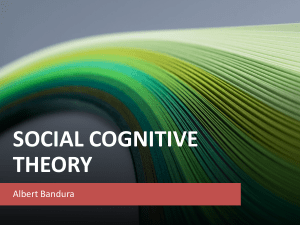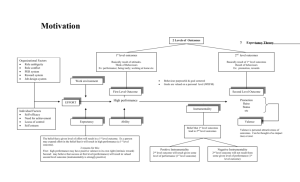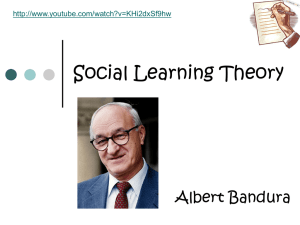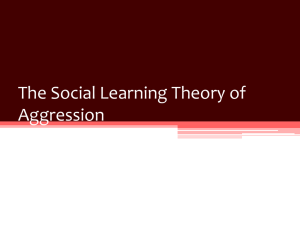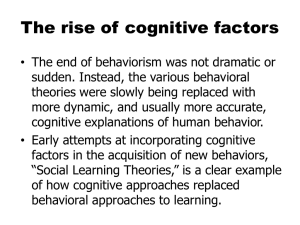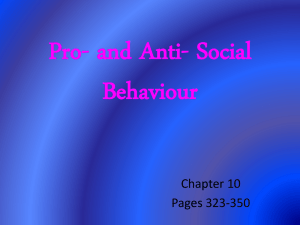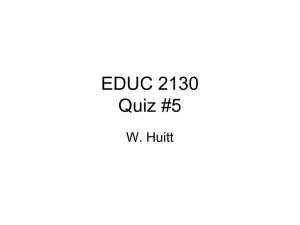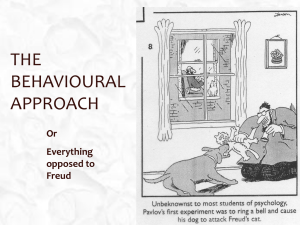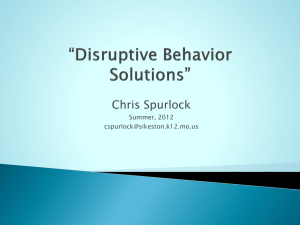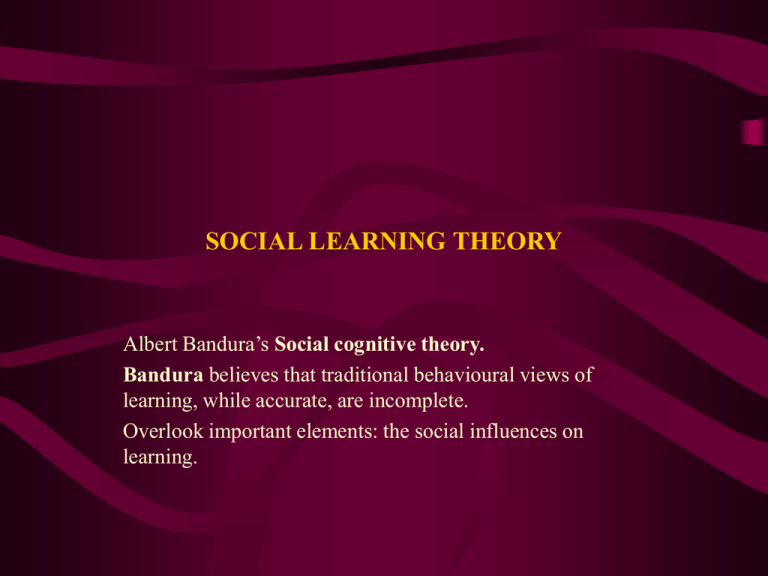
SOCIAL LEARNING THEORY
Albert Bandura’s Social cognitive theory.
Bandura believes that traditional behavioural views of
learning, while accurate, are incomplete.
Overlook important elements: the social influences on
learning.
ELEMENTS OF SOCIAL COGNITIVE THEORY
• Bandura distinguishes between the acquisition of knowledge (learning)
and the observable performance based on that knowledge or
(behaviour)
• Both internal and external factors are important., interacting in the
process of learning.
• Reciprocal Determinism. An explanation of behaviour that
emphasizes the mutual effects of the individual and the environment
on each other.
• Distinction between enactive and vicarious learning. Enactive learning
is learning by doing and experiencing the consequences of your
actions. Consequences are seen as providing information about
appropriate actions, creating expectations, and influencing motivation.
• Vicarious learning is learning by observing others. Emphasizes the
powerful effect that modelling and imitation can have on learning
LEARNING BY OBSERVING OTHERS
• Two main modes of
observational learning (OL).
• First, OL can take place through
vicarious reinforcement.
• Second, Imitates the behaviour
of a model even though the
model receives no
reinforcement or punishment
while the observer is watching.
• Observation can be a very
efficient learning process.
• Social Cognitive distinguishes
between acquisition and
performance.
• Four important elements to be
considered in OL: Attention,
retention, production, and
motivation and reinforcement.
• Motivation and Reinforcement
• If there is some motivation or
incentive to do. Reinforcement
can play several roles in OL
Three Forms of Reinforcement that encourage OL
• 1. The observer may produce
and receives direct
reinforcement.
• 2. The reinforcement need not
be direct - it may be vicarious.
• 3. Self-reinforcement or
controlling your own
reinforcers. We want our
students to improve not because
it leads to external rewards but
because students value and
enjoy their growing
competence.
Factors Influence OL
What causes an individual to learn and perfomr modelled
behaviours?
• 1.The developmental level of
the observer makes a difference
in learning. Focus attention for
longer periods, use memory
strategies and motivate to
practise.
• 2. The status of the model.
More likely to imitate the
actions of others who seem
competent, powerful, and
prestigious.
• 3. By watching others. Models
who are seen as similar are
more readily to imitated
Factors influence OL (cont.)
• All students need to be successful, capable models who look and sound
like them, no matter what their ethnicity, socioeconomic status, or sex.
• The last three influences involve goals and expectations
• A. If they expect that certain actions of model will lead to particular
outcomes
• B. Value those outcomes or goals. Then pay more attention and try to
reproduce their behaviours.
• C. More likely to learn from the models if they have a high level of
self-efficacy - if they believe they are capable of doing the actions
needed to reach the goals or at leas of learning how to do so
OBSERVATIONA LLEARNING IN TEACHING
Five possible outcomes
• 1. Teaching new behaviours.
Modelling can be applied
deliberately in the classroom to
teach mental skills and to
broaden horizons - to teach new
ways of thinking.
• Modelling, when applied
deliberately, can be effective
and efficient means of teaching
new behaviour. Use all
elements of OL, especially
reinforcement and practice.
Models who are the same
age….
• 2. Encouraging alreadylearned behaviours. All of us
have had the experience of
looking for cues from other
people when we find ourselves
in unfamiliar situations.
• Observing the behaviour of
others tell us much of which our
already learned-behaviours to
use
O.L. IN TEACHING (cont.)
Teaching new behaviours and attitudes, encouraging existing
behaviours, changing inhibitions, directing attention, and arousing
emotions.
• 3. Strengthening or Weakening
inhibitions. The ripple effect.
• If class members witness one
student breaking a class rule
and getting way with it, they
may learn that undesirable
consequences do not always
follow rule breaking. The class
may be less inhibited in the
future about breaking this rule.
• When the teacher deal
effectively with a rule breaker,
especially a class leader, the
idea of breaking this rule may
be inhibited for other students
viewing the interaction. Once
the teacher has called for a
particular action, following
through is an important part of
capitalizing on the ripple effect.
O.L. IN TEACHING
Teaching new behaviours and attitudes, encouraging existing
behaviours, changing inhibitions, directing attention, and arousing
emotions.
• 4.Directing attention
• 5. Arousing Emotion. OL people may develop emotional reactions to
situations they themselves have never experienced. Students may be
anxious when they are assigned to a certain teacher because they’ve
heard frightening stories about how “mean” that teacher is.
• Note that hearing and reading about a situation are also forms of
observation
• The guidelines will give you some ideas about using OL in the
classroom.
SELF-REGULATION AND COGNITIVE BEHAVIOUR
MODIFICATION
• BEHVIOURAL VIEWS on
learning emphasizes selfmanagement - helping students
gain control of their own
learning. Students taught with
classic behavioural methods
seldom generalized their
learning to new situations.
• Genenralization would be
encouraged if students became
partners in the behaviour
change procedures.
• Self-management. The goal of
education is to produce people
who are capable of educating
themselves, then students must
learn to manage their own lives,
set their own goals, and to
provide their own
reinforcement.
• They may help set goal set
goals, observe their own work,
keep records of it, and evaluate
their own performance.
COGNITIVE BEHAVIOUR MODIFICATION (CBM)
AND SELF-INSTRUCTION
• SELF-MANAGEMENT generally means getting students involved in
the basic steps of a behaviour change program.
• COGNITIVE BEHAVIOUR MODIFICATION adds an emphasis on
thinking and self talk.
• Remember CHILDREN GUIDE THEMSELVES THROUGH A TASK
BY USING PRIVATE SPEECH.
• In Cognitive behaviour modification, students are taught directly how
to use self-instruction and many components include dialogue and
interaction between teacher and student, modelling, guided discovery,
motivational strategies, feedback, careful matching of the task with the
student’s developmental level and other principles of good teaching.
Students do seem to generalize the skills developed with CBM to new
learning situations
PROBLEMS AND ISSUES
• Provide an overview of several
strategies for changing
classroom behviour.
• Should be aware that these
strategies are tools that may be
used RESPONSIBLY OR
IRRESPONSIBLY. Some issues
should keep in mind.
• 1. Ethical Issues .
• What are goals?
• How do these goals fit with
those of the school as a whole?
• Might students be rewarded for
the ‘wrong’ thing, though it
seems ‘right’ at first?
• By what criteria should
strategies be chosen?
• What effect will a strategy have
on the individual involved?
• Is too much control being given
to the teacher or to a majority?
PROBLEMS AND ISSUES (cont’)
• Goals. Whenever possible emphasis should be placed on academic
learning. Academic improvement generalize to other situations more
successfully than do changes in classroom conduct.
• Strategies. Punishment can have negative side effects. And is
unnecessary and even unethical when positive approaches, which a
fewer potential dangers, might work as well.
• When simpler, less-restrictive procedures fail, then more complicated
procedures should be tried.
• Consider the impact of the strategy on the individual student.
• Home-based reinforcement program might be very harmful to students
who have a history of being severely punished at home for bad reports
from school. So reports of unsatisfactory progress at school could lead
to increased abuse at home.
CRITICISM OF BEHAVIOURAL METHODS
• Properly used can be effective tools to help students learn
academically grow in self-sufficiency.
• Effective tolls do not automatically produce excellent work.
• The indiscriminate use of even the best tools can lead to difficulties.
• Rewarding for learning will cause them to lose interest in learning for
its own sake.
• Take into account the effects of a reward system on the individula,
also consider the impact on other students.
• Using a reward program or giving one student increased attention may
have a detrimental effect on the other students in the classroom.

